Top Skills to Elevate Customer Service Performance

Customer service is evolving faster than ever. By 2025, you’ll need a mix of interpersonal and technical skills to keep up with rising expectations. Did you know 59% of consumers now expect better service than they did just a year ago? That’s not all—80% value their experience as much as the product itself. To meet these demands, skills like effective communication and problem-solving are no longer optional. They’re essential. Tools like Sobot can help you stay ahead, but mastering customer service key skills will set you apart in this competitive landscape.
Why Customer Service Key Skills Are Crucial in 2025
The evolving role of customer service in business success
Customer service is no longer just about solving problems. It’s now a key driver of business success. Companies that prioritize customer experience can see a 2-7% increase in sales revenue and a 1-2% boost in profitability. Why? Because customers are willing to spend more when they feel valued. In fact, 85% of people say they’d go out of their way for better service. This means mastering customer service key skills isn’t just a nice-to-have—it’s a must-have for staying competitive.
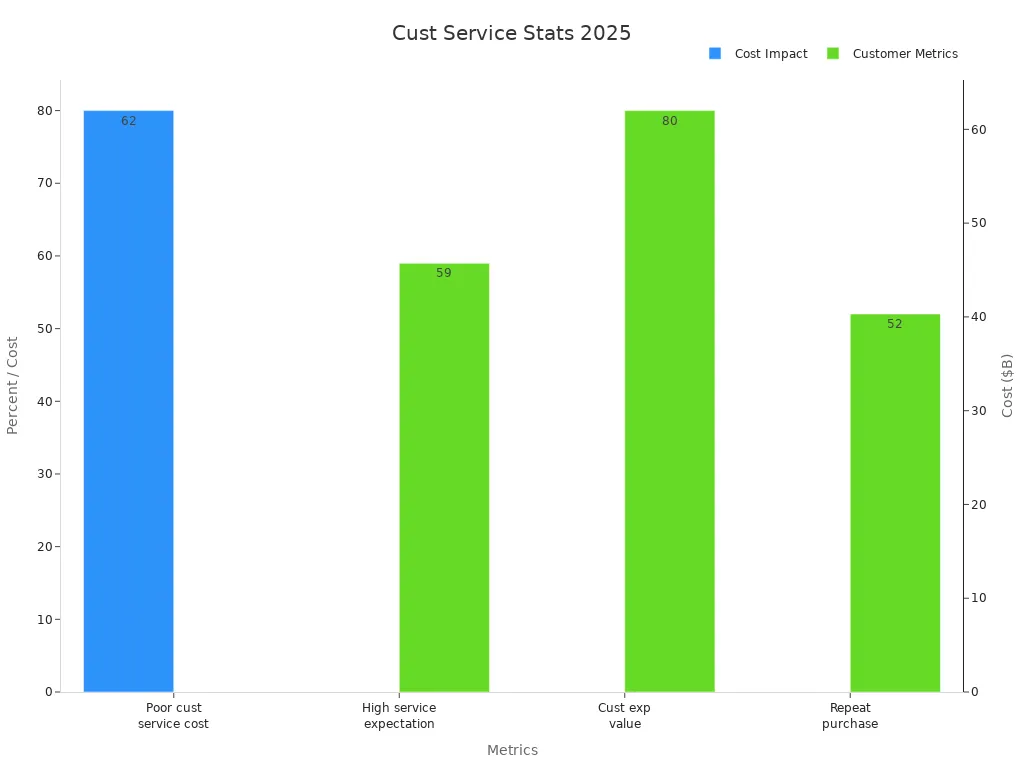
How customer expectations are shaping the future of service
Your customers expect more than ever before. Over 76% want seamless interactions across all channels, and 58% say their expectations have risen since the pandemic. They don’t just want answers—they want personalized experiences. Imagine walking into a store where the staff knows your name and preferences. That’s the level of service people now expect online too. Businesses that invest in data analytics to predict customer needs and tailor their services will lead the pack.
The impact of customer service on brand reputation and loyalty
Did you know 63% of customers would leave a brand after just one bad experience? Even loyal customers aren’t immune—86% would abandon a company after two or three poor interactions. On the flip side, 89% are more likely to return after a positive experience. This shows how essential customer service skills can make or break your brand’s reputation. When you focus on building trust and delivering exceptional service, you’re not just solving problems—you’re creating lifelong customers.
Effective Communication: The Foundation of Customer Service
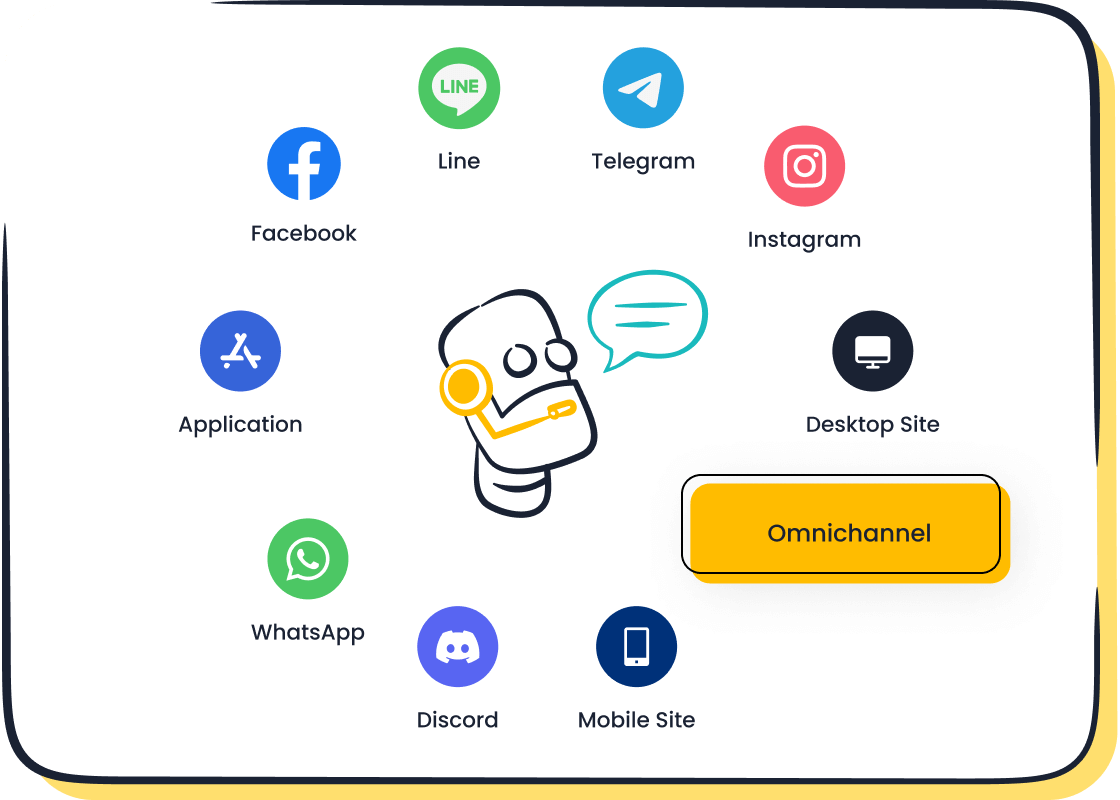
What makes communication effective in customer interactions
Effective communication is the backbone of every great customer service experience. It’s not just about what you say but how you say it. Clear communication ensures your customers fully understand the solutions or instructions you provide. For example, explaining a return policy step-by-step leaves no room for confusion and sets the right expectations.
Customers value clarity and responsiveness. In fact, 75% of them say prompt, personalized answers are the most important aspect of service. When you communicate clearly, you build trust and confidence, making customers feel valued.
Here’s a quick look at why effective communication matters:
| Statistic | Insight |
|---|---|
| 83% | Customers feel more loyal to brands that resolve complaints effectively. |
| 62% | Customers want seamless engagement across multiple digital channels. |
| 83% | Good customer service influences purchase decisions. |
Active listening as a cornerstone of customer satisfaction
Listening is more than just hearing words. Active listening means focusing on what your customer is saying, understanding their needs, and responding thoughtfully. This approach helps you uncover the real issue behind their concerns.
For instance, when a customer feels heard, they’re more likely to trust your solutions. Active listening also boosts customer satisfaction by ensuring you address their needs fully. Research shows that combining active listening with emotional intelligence helps manage sensitive situations effectively.
| Trait | Benefit in Customer Service |
|---|---|
| Active Listening | Understands customer needs fully |
| Emotional Intelligence | Manages sensitive situations |
Tips for improving verbal, written, and digital communication
Improving your communication skills doesn’t have to be complicated. Here are some practical tips:
- Be concise and direct. Use simple language to make solutions easy to understand.
- Confirm understanding. Reiterate key points to avoid confusion.
- Use positive language. Frame responses constructively to keep the conversation upbeat.
Role-playing scenarios can also help you practice clear communication skills. Regular feedback from customers and team members will refine your approach over time.
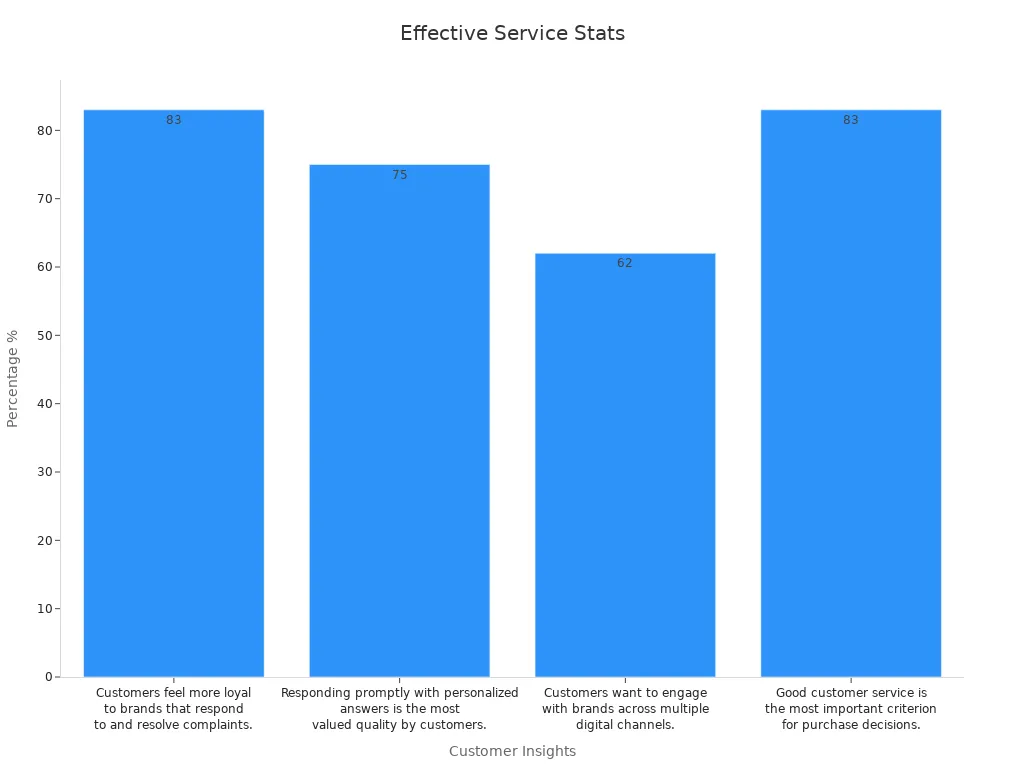
Proactive Problem-Solving: Anticipating and Addressing Customer Needs
The importance of identifying customer pain points early
Understanding your customers' pain points early can transform your service approach. When you identify these issues proactively, you not only enhance customer satisfaction but also reduce churn. Think about it—if you address a problem before it escalates, you’re showing customers that you value their time and experience.
Here’s why this matters:
- Early recognition of pain points improves service efficiency.
- Ignoring these issues often drives customers to competitors.
- Proactively addressing concerns builds trust and strengthens customer relationships.
By focusing on these pain points, you position yourself as a responsive and customer-centric brand. This approach isn’t just about solving problems; it’s about building rapport and fostering loyalty.
Creative approaches to resolving complex issues
Sometimes, traditional methods won’t cut it. Complex problems require innovative solutions. For instance, Elena Martinez scaled a customer engagement platform globally by investing in adaptable technology. Similarly, Gabriella Rossi improved sustainability in manufacturing by encouraging continuous improvement. These examples show how creative problem-solving can lead to remarkable outcomes.
A study by the World Economic Forum found that companies prioritizing innovation are 2.5 times more likely to lead their markets. This highlights the importance of thinking outside the box. Whether it’s through technology or empowering your team, creative approaches can redefine how you handle challenges and strengthen customer relationships.

How Sobot's Chatbot enhances problem-solving efficiency
Sobot’s AI Chatbot is a game-changer for proactive problem-solving. It operates 24/7, handling routine queries and freeing up your team to focus on complex issues. With a correct answers rate of 80% and a customer satisfaction score of over 96%, it’s clear how effective this tool is.
Here’s a snapshot of its performance:
| Metric | Value |
|---|---|
| Reduction in inbound discussion | 20% |
| Customer satisfaction score | 96%+ |
| Problem resolution rate | 85% |
| Customer happiness rate | 99% |

The chatbot doesn’t just resolve issues—it builds stronger customer relationships by delivering fast, accurate, and personalized solutions. For example, Maruti Suzuki’s chatbot engaged over 400,000 users, handling millions of queries and even facilitating bookings. This level of efficiency shows how Sobot’s Chatbot can elevate your problem-solving abilities and improve customer satisfaction.
Empathy and Emotional Intelligence: Building Strong Customer Connections

Understanding and addressing customer emotions effectively
Understanding customer emotions is key to delivering exceptional service. When you connect with customers on an emotional level, you show them that their concerns matter. But how can you do this effectively?
- Consider the customer’s perspective. Put yourself in their shoes to understand their frustrations or needs.
- Focus fully on the customer. Avoid distractions and give them your undivided attention.
- Develop emotional intelligence. This helps you recognize and respond to emotions, improving satisfaction and loyalty.
Active listening plays a big role here. When you acknowledge a customer’s feelings and validate their concerns, you build trust. For example, saying, “I understand how frustrating this must be for you,” shows you care. Personalized responses also make a difference. Tailoring your approach to each customer’s situation creates a more meaningful connection.
Tip: Use phrases like “I hear you” or “Let me help you with that” to show empathy and understanding.
Strategies for developing emotional intelligence in teams
Building emotional intelligence within your team doesn’t happen overnight. It requires consistent effort and the right strategies. Here’s how you can get started:
- Provide training programs. Teach your team how to manage emotions and recognize customer cues.
- Encourage active listening. Help agents focus on understanding customer concerns fully.
- Offer continuous feedback. Use surveys and performance reviews to refine their skills.
- Role-play scenarios. Practice handling challenging situations to build confidence.
These strategies not only improve individual skills but also create a culture of empathy within your team. When your team feels supported, they’re better equipped to support your customers.
How empathy fosters trust and long-term relationships
Empathy is the foundation of trust. When customers feel understood, their frustration decreases, and their trust in your brand grows. This trust leads to stronger, long-term relationships. For instance, if a customer has a problem and you respond with genuine care, they’re more likely to stay loyal.
Empathy-driven service also enhances the overall experience. Customers who feel valued are more likely to recommend your brand to others. By adopting a people-first approach, you can exceed expectations and turn one-time buyers into lifelong advocates.
Note: Empathy isn’t just about solving problems. It’s about showing customers that you genuinely care about their needs.
Adaptability and Resilience: Thriving in a Dynamic Customer Service Environment
Adjusting to changing customer needs and expectations
Customer needs are constantly evolving, and staying ahead requires flexibility. You can’t rely on a one-size-fits-all approach anymore. Customers expect personalized experiences, and adapting to their preferences is key to delivering good customer service. Tools like data analytics can help you predict trends and adjust your strategies in real time. For example, analyzing customer feedback can reveal common pain points, allowing you to address them proactively.
Here’s how adaptability contributes to better service:
| Aspect | Contribution to Customer Service Performance |
|---|---|
| Adaptability | Enables agents to switch between communication channels effectively. |
| Allows adjustment to new market trends and changing customer needs. |
Proactive outreach is another effective strategy. By anticipating customer needs, you can solve problems before they arise. This not only reduces support tickets but also makes customers feel valued and understood. Employee training also plays a vital role in helping your team stay agile and responsive.
Staying calm and effective under pressure
Handling upset customers or high-pressure situations is part of the job. Staying calm can make all the difference. A composed demeanor reassures customers that their concerns are manageable. It also helps you focus on finding solutions instead of reacting emotionally.
Here’s why staying calm matters:
- It defuses tension and fosters productive dialogue.
- It rebuilds trust by showing customers you’re in control.
- It improves decision-making by reducing stress-driven actions.
When you remain calm, you create a positive experience even in challenging situations. This is a hallmark of good customer service and leaves a lasting impression on your customers.
Developing a growth mindset for continuous improvement
A growth mindset is essential for thriving in today’s dynamic environment. It encourages you to view challenges as opportunities to learn and improve. Nearly 90% of executives believe this mindset is crucial for success. By fostering a culture of continuous learning, you can enhance your team’s ability to adapt and meet customer needs effectively.
Here’s how you can develop a growth mindset:
- Encourage feedback and use it to refine your approach.
- Provide training programs to build new skills.
- Lead by example. When leaders demonstrate a growth mindset, it inspires the entire team.
Adopting this mindset not only improves service quality but also boosts team morale. It’s a win-win for both your employees and your customers.
Technical Knowledge and Digital Proficiency: Leveraging Tools for Success
The role of AI and automation in modern customer service
AI and automation are transforming customer service. You’ve probably noticed how chatbots and virtual assistants make interactions faster and smoother. Companies like Delta Airlines have seen huge improvements with tools like their “Ask Delta” chatbot, which reduces wait times and boosts satisfaction. Similarly, Maruti Suzuki’s AI chatbot handled millions of queries and even facilitated bookings for over 400,000 users.
Why does this matter? AI doesn’t just speed things up—it creates hyper-personalized experiences that customers love. Research shows that these tailored interactions can increase revenue by up to 40%. Plus, AI tools allow you to focus on complex issues while routine queries are handled automatically. In fact, 90% of early AI adopters believe that 80% of customer service issues will soon be resolved without human intervention.
Tip: AI won’t replace your job. It’ll make it easier by giving you more time to focus on meaningful customer interactions.
How Sobot's Omnichannel Solution streamlines customer interactions
Sobot’s Omnichannel Solution is a game-changer for customer service. It integrates all communication channels—email, social media, voice calls—into one unified workspace. This means you can manage everything from a single platform, saving time and reducing errors.
Here’s what Sobot’s solution delivers:
| Statistic/Case Study | Description |
|---|---|
| Inbound Volume Reduction | Reduced inbound discussion volume by 20% and increased positive feedback to 96%+. |
| Correct Answers Rate | Over 80% of answers are correct, with a customer satisfaction score of 95%+. |
| Self-Service Rate | 22.2% of questions answered independently, achieving a CSAT score of 97%. |
| Problem Resolution Rate | Solved 85% of problems, leading to 99% customer satisfaction. |
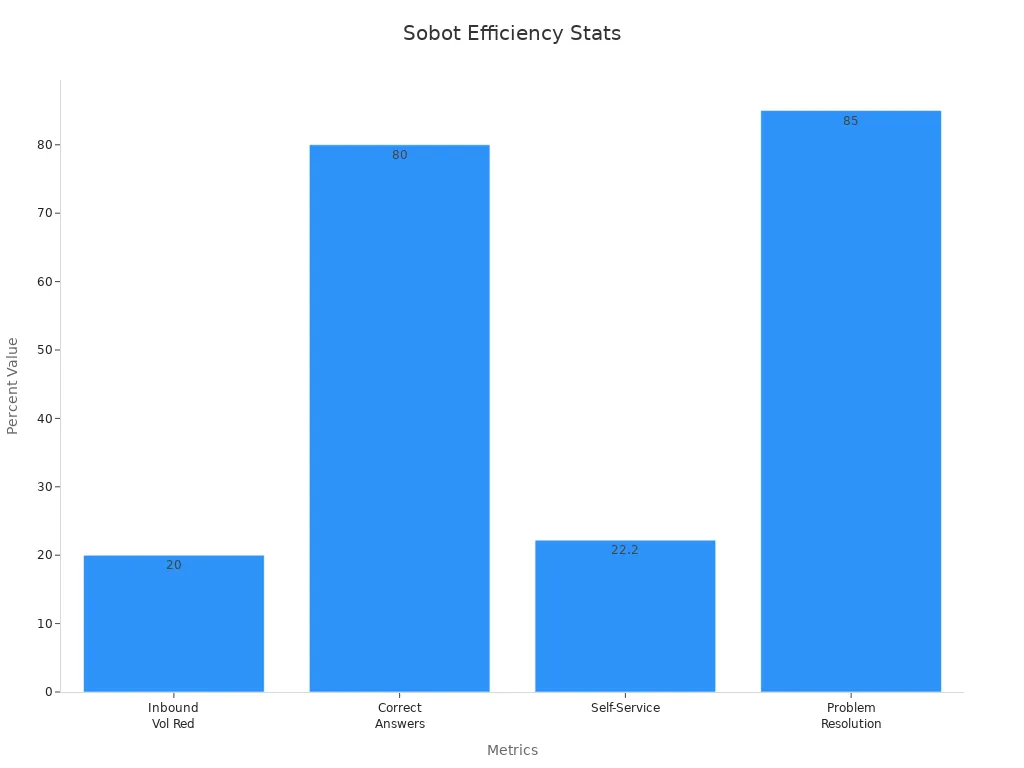
By using Sobot’s AI-driven tools, you can provide faster, more accurate service while improving customer satisfaction. It’s not just about solving problems—it’s about creating seamless experiences that keep customers coming back.
Staying updated with emerging technologies and tools
Technology evolves quickly, and staying ahead is crucial. Tools like real-time sentiment analysis help you respond better by analyzing voice cues and text. Advanced analytics can reveal trends in customer behavior, allowing you to adapt your strategies in real time.
Companies using these technologies report faster response times and higher satisfaction ratings. Emotional AI, for example, is projected to reach a market value of $91.67 billion. This shows how important it is to embrace innovation.
Note: Staying updated isn’t just about learning new tools. It’s about understanding how they can improve your service and make your job easier.
How to Develop and Apply These Skills Effectively
Training programs and workshops for skill enhancement
Training programs and workshops are essential for building strong customer service skills. They provide a structured way to learn and practice techniques that improve customer communication and problem-solving abilities. Workshops often include role-playing exercises, where you can simulate real-world scenarios and receive feedback from peers. This hands-on approach helps you refine your responses and fosters a culture of continuous improvement.
Regular training sessions also keep you updated on the latest tools and techniques. For example, learning how to use AI-driven solutions like Sobot's Chatbot can make your work more efficient. Monitoring customer satisfaction scores after training can show how these programs improve service quality. Higher scores often indicate better customer experiences, proving the value of ongoing education.
Tip: Schedule monthly workshops to keep your skills sharp and stay ahead of customer expectations.
Role-playing and real-world practice for practical learning
Role-playing is one of the best ways to prepare for real-world challenges. It allows you to practice handling difficult situations in a safe environment. For instance, you can simulate scenarios like addressing an upset customer or explaining a complex policy. This builds confidence and helps you develop empathy.
Here’s how role-playing benefits customer service:
| Evidence Type | Description |
|---|---|
| Role-playing | Prepares agents for real-world challenges and develops empathy in a safe setting. |
| Feedback | Refines active listening skills and highlights communication cues. |
| Adaptability | Exploring different approaches improves adaptability in customer service scenarios. |
Real-world practice is equally important. By applying what you’ve learned during actual customer interactions, you can identify areas for improvement. Combining role-playing with real-world experience ensures you’re ready for any situation.
Leveraging feedback and performance reviews for growth
Feedback is a powerful tool for growth. Collecting feedback from customers and team members helps you understand what’s working and what needs improvement. Use multiple channels to gather feedback, such as post-interaction surveys or anonymous submissions.
Once you’ve collected feedback, analyze it to identify common themes. Focus on high-impact areas to make meaningful changes. For example, if customers frequently mention slow response times, you can prioritize training on faster problem-solving techniques.
Here’s a step-by-step guide to leveraging feedback:
| Step | Description |
|---|---|
| Collect Comprehensive Feedback | Use various channels to gather feedback, ensuring a holistic understanding of customer opinions. |
| Analyze the Feedback | Categorize feedback to identify common themes and prioritize issues based on frequency and severity. |
| Implement Changes | Start with small changes for quick wins, then develop strategic plans for larger issues. |
| Communicate with Customers | Acknowledge and appreciate customer feedback, informing them about changes made based on their input. |
| Monitor and Iterate | Track KPIs like customer satisfaction scores to measure the impact of changes and establish a continuous feedback loop. |
Sobot’s solutions can help you build a culture of continuous learning. For example, its tools have been shown to reduce inbound discussions by 20% and achieve a 96% customer satisfaction score.
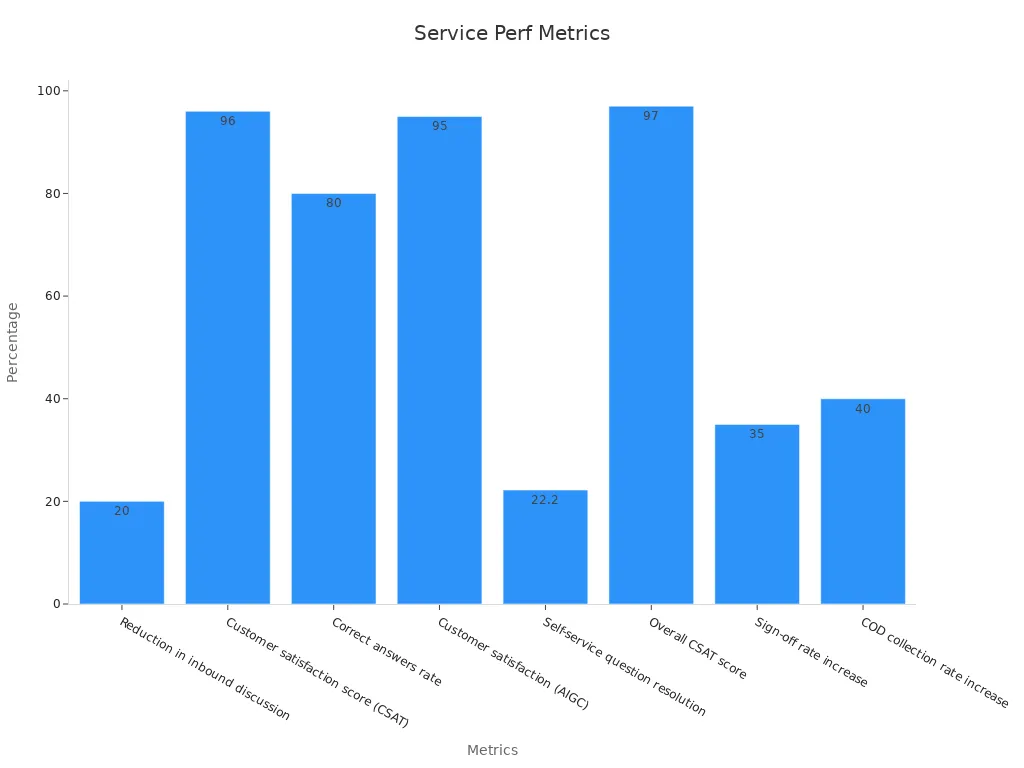
By leveraging feedback and using tools like Sobot, you can continuously improve your skills and deliver exceptional, personalized interactions.
Building a culture of continuous learning with Sobot's solutions
Creating a culture of continuous learning isn’t just a nice-to-have—it’s essential for staying ahead in customer service. When your team embraces learning, they’re better equipped to adapt to new challenges and deliver exceptional service. But how do you make this happen? That’s where Sobot’s solutions come in.
Sobot offers tools that make learning part of your team’s daily routine. For example, the Sobot Omnichannel Solution provides real-time analytics and insights. These features help your team identify areas for improvement and track their progress. Imagine being able to see which communication channels need more attention or which types of queries take the longest to resolve. This data empowers your team to focus on what matters most.
Tip: Use Sobot’s reporting tools to set measurable goals for your team. Tracking metrics like response time and customer satisfaction can motivate everyone to improve.
Another way to foster learning is through feedback. Sobot’s platform makes it easy to collect and analyze customer feedback. You can use this information to identify training opportunities and refine your team’s approach. For instance, if customers frequently mention slow response times, you can prioritize training on speed and efficiency.
Role-playing and practice are also key. With Sobot’s AI-powered Chatbot, your team can simulate real-world scenarios. The chatbot handles routine queries, giving your agents more time to focus on complex issues. This hands-on experience builds confidence and sharpens problem-solving skills.
By integrating Sobot’s solutions into your operations, you’re not just improving customer service—you’re creating a team that’s always learning and growing. That’s the kind of culture that leads to long-term success.
Ready to start building your learning culture? Explore Sobot’s tools here.
The future of customer service depends on mastering both interpersonal and technical skills. By focusing on effective communication, proactive problem-solving, empathy, adaptability, and technical proficiency, you can deliver exceptional experiences. Trends like high responsiveness and proactive engagement show how vital these skills are. For example, personalized service not only boosts satisfaction but also costs five times less than acquiring new customers.
Tools like Sobot’s Chatbot and Omnichannel Solution make this easier by streamlining interactions and enhancing efficiency. With continuous learning and the right tools, you’ll stay ahead in 2025’s competitive landscape.
Tip: Start building these skills today to create lasting customer relationships!
FAQ
What is the most important skill for customer service in 2025?
Empathy stands out as the most crucial skill. When you understand and connect with customers emotionally, you build trust and loyalty. This makes them feel valued and improves their overall experience.
Tip: Practice active listening to enhance your empathy skills.
How can Sobot's Chatbot help my team?
Sobot's Chatbot handles routine queries 24/7, saving your team time for complex issues. It boosts efficiency by 70% and reduces costs by up to 50%. Plus, it’s easy to set up—no coding required!
Why is adaptability important in customer service?
Customer needs change constantly. Adaptability helps you adjust quickly to new expectations, tools, or challenges. This keeps your service relevant and ensures customers stay satisfied.
How does Sobot's Omnichannel Solution improve customer interactions?
It unifies all communication channels into one workspace. This means you can respond faster and more accurately. It also provides analytics to help you optimize your service.
Note: A unified workspace reduces errors and boosts productivity by 30%.
How can I start building a culture of continuous learning?
Start with regular training sessions and workshops. Use tools like Sobot’s analytics to identify skill gaps. Encourage feedback and role-playing to refine your team’s approach.
Emoji Tip: 📚 Learning never stops—keep improving every day!
See Also
Enhancing Customer Satisfaction Through Effective Live Chat Strategies
Essential Practices for Managing Call Center Quality Effectively
Improving Call Center Efficiency Through Effective Performance Monitoring
Enhancing Operational Efficiency with AI-Driven Customer Service Tools